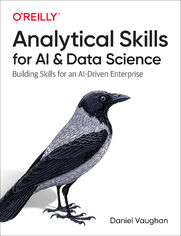Analytical Skills for AI and Data Science. Building Skills for an AI-Driven Enterprise - Helion

ISBN: 9781492060895
stron: 244, Format: ebook
Data wydania: 2020-05-21
Ksi─Ögarnia: Helion
Cena ksi─ů┼╝ki: 211,65 z┼é (poprzednio: 246,10 z┼é)
Oszczędzasz: 14% (-34,45 zł)
While several market-leading companies have successfully transformed their business models by following data- and AI-driven paths, the vast majority have yet to reap the benefits. How can your business and analytics units gain a competitive advantage by capturing the full potential of this predictive revolution? This practical guide presents a battle-tested end-to-end method to help you translate business decisions into tractable prescriptive solutions using data and AI as fundamental inputs.
Author Daniel Vaughan shows data scientists, analytics practitioners, and others interested in using AI to transform their businesses not only how to ask the right questions but also how to generate value using modern AI technologies and decision-making principles. You’ll explore several use cases common to many enterprises, complete with examples you can apply when working to solve your own issues.
- Break business decisions into stages that can be tackled using different skills from the analytical toolbox
- Identify and embrace uncertainty in decision making and protect against common human biases
- Customize optimal decisions to different customers using predictive and prescriptive methods and technologies
- Ask business questions that create high value through AI- and data-driven technologies
Osoby które kupowały "Analytical Skills for AI and Data Science. Building Skills for an AI-Driven Enterprise", wybierały także:
- Windows Media Center. Domowe centrum rozrywki 66,67 zł, (8,00 zł -88%)
- Ruby on Rails. ─ćwiczenia 18,75 z┼é, (3,00 z┼é -84%)
- Efekt piaskownicy. Jak szefować żeby roboty nie zabrały ci roboty 59,50 zł, (11,90 zł -80%)
- Przyw├│dztwo w ┼Ťwiecie VUCA. Jak by─ç skutecznym liderem w niepewnym ┼Ťrodowisku 58,64 z┼é, (12,90 z┼é -78%)
- Scrum. O zwinnym zarz─ůdzaniu projektami. Wydanie II rozszerzone 58,64 z┼é, (12,90 z┼é -78%)
Spis tre┼Ťci
Analytical Skills for AI and Data Science. Building Skills for an AI-Driven Enterprise eBook -- spis tre┼Ťci
- Preface
- Why Analytical Skills for AI?
- Use Case-Driven Approach
- What This Book Isnt
- Who This Book Is For
- Whats Needed
- Conventions Used in This Book
- Using Code Examples
- OReilly Online Learning
- How to Contact Us
- Acknowledgments
- 1. Analytical Thinking and the AI-Driven Enterprise
- What Is AI?
- Why Current AI Wont Deliver on Its Promises
- How Did We Get Here?
- The Data Revolution
- The three Vs
- Data maturity models
- Descriptive stage
- Predictive stage
- Prescriptive stage
- The Data Revolution
- A Tale of Unrealized Expectations
- Analytical Skills for the Modern AI-Driven Enterprise
- Key Takeways
- Further Reading
- 2. Intro to Analytical Thinking
- Descriptive, Predictive, and Prescriptive Questions
- When Predictive Analysis Is Powerful: The Case of Cancer Detection
- Descriptive Analysis: The Case of Customer Churn
- Describing churn
- Predicting churn
- Prescribing courses of action to reduce churn
- Business Questions and KPIs
- KPIs to Measure the Success of a Loyalty Program
- An Anatomy of a Decision: A Simple Decomposition
- An Example: Why Did You Buy This Book?
- A Primer on Causation
- Defining Correlation and Causation
- Some Difficulties in Estimating Causal Effects
- Problem 1: We cant observe counterfactuals
- Problem 2: Heterogeneity
- Problem 3: Confounders
- Problem 4: Selection effects
- A/B testing
- Uncertainty
- Uncertainty from Simplification
- Uncertainty from Heterogeneity
- Uncertainty from Social Interactions
- Uncertainty from Ignorance
- Key Takeaways
- Further Reading
- Descriptive, Predictive, and Prescriptive Questions
- 3. Learning to Ask Good Business Questions
- From Business Objectives to Business Questions
- Descriptive, Predictive, and Prescriptive Questions
- Always Start with the Business Question and Work Backward
- Further Deconstructing the Business Questions
- Example with a Two-Sided Platform
- Learning to Ask Business Questions: Examples from Common Use Cases
- Lowering Churn
- Defining the business question
- Descriptive questions
- Predictive questions
- Prescriptive questions
- Cross-Selling: Next-Best Offer
- Defining the business question
- Descriptive questions
- Predictive questions
- Prescriptive questions
- CAPEX Optimization
- Store Locations
- Who Should I Hire?
- Delinquency Rates
- Stock or Inventory Optimization
- Store Staffing
- Lowering Churn
- Key Takeaways
- Further Reading
- 4. Actions, Levers, and Decisions
- Understanding What Is Actionable
- Physical Levers
- Human Levers
- Why Do We Behave the Way We Do?
- Levers from Restrictions
- Time restrictions
- Levers That Affect Our Preferences
- Genetics
- Individual and social learning
- Social reasons: strategic effects
- Social reasons: conformity and peer effects
- Framing effects
- Loss aversion
- Levers That Change Your Expectations
- The availability and representativeness heuristics
- Revisiting Our Use Cases
- Customer Churn
- Cross-Selling
- Capital Expenditure (CAPEX) Optimization
- Store Locations
- Who Should I Hire?
- Delinquency Rates
- Stock Optimization
- Store Staffing
- Key Takeaways
- Further Reading
- 5. From Actions to Consequences: Learning How to Simplify
- Why Do We Need to Simplify?
- First- and Second-Order Effects
- Exercising Our Analytical Muscle: Welcome Fermi
- How Many Tennis Balls Fit the Floor of This Rectangular Room?
- How Much Would You Charge to Clean Every Window in Mexico City?
- Fermi Problems to Make Preliminary Business Cases
- Paying our customers for their contact info
- Excessive contact attempts increase the probability of churn
- Should you accept the offer from that startup?
- Revisiting the Examples from Chapter 3
- Customer Churn
- Cross-Selling
- CAPEX Optimization
- Price effect
- Quantity effect
- Store Locations
- Delinquency Rates
- Stock Optimization
- Store Staffing
- Key Takeaways
- Further Reading
- Why Do We Need to Simplify?
- 6. Uncertainty
- Where Does Uncertainty Come From?
- Quantifying Uncertainty
- Expected Values
- Bidding for a highway construction contract
- Interpreting expected values
- Expected Values
- Making Decisions Without Uncertainty
- Making Simple Decisions Under Uncertainty
- Decisions Under Uncertainty
- Is This the Best We Can Do?
- But This Is a Frequentist Argument
- Normative and Descriptive Theories of Decision-Making
- Some Paradoxes in Decision-Making Under Uncertainty
- The St. Petersburg Paradox
- Risk Aversion
- Putting it All into Practice
- Estimating the Probabilities
- Estimating unconditional probabilities
- Estimating conditional probabilities
- A/B testing
- Bandit problems
- Estimating Expected Values
- Frequentist and Bayesian Methods
- Estimating the Probabilities
- Revisiting Our Use Cases
- Customer Churn
- Cross-Selling
- CAPEX Optimization
- Store Locations
- Who to Hire
- Delinquency Rates
- Stock Optimization
- Key Takeaways
- Further Reading
- 7. Optimization
- What Is Optimization?
- Numerical Optimization Is Hard
- Optimization Is Not New in Business Settings
- Price and Revenue Optimization
- Optimization Without Uncertainty
- Customer Churn
- Cross-Selling
- CAPEX Investment
- Optimal Staffing
- Optimal Store Locations
- Optimization with Uncertainty
- Customer Churn
- Cross-Selling
- Optimal Staffing
- Tricks for Solving Optimization Problems Under Uncertainty
- Key Takeaways
- Further Reading
- What Is Optimization?
- 8. Wrapping Up
- Analytical Skills
- Asking Prescriptive Questions
- Understanding Causality
- Thinking outside the box
- Simplify
- Embracing Uncertainty
- Do-nothing approach
- The data-driven approach
- The model-driven approach
- Tackling Optimization
- Understanding the objective function
- Dealing with local optima
- Sensitivity to initial guesses
- Scaling and production issues
- The AI-Driven Enterprise of the Future
- Back to AI
- Learning how to make decisions
- Some problems with this approach to automatic decision-making
- Ethics
- Back to AI
- Some Final Thoughts
- Analytical Skills
- A. A Brief Introduction to Machine Learning
- What Is Machine Learning?
- A Taxonomy of ML Models
- Supervised Learning
- Unsupervised Learning
- Semisupervised Learning
- Regression and Classification
- Making Predictions
- Caveats to the Plug-in Approach
- Where Do These Functions Come From?
- Making Good Predictions
- From Linear Regression to Deep Learning
- Linear Regression
- Controlling for other variables
- Overfitting
- Neural Networks
- Activation functions: adding some extra nonlinearity
- The success of deep learning
- Linear Regression
- A Primer on A/B Testing
- A/B testing in practice
- Understanding power and size calculations
- False positives and false negatives
- Further Reading
- Index





